The Microsoft Surface Laptop 3 (15-Inch) Review: AMD Ryzen Surface Edition
by Brett Howse on October 21, 2019 9:00 AM EST- Posted in
- Laptops
- AMD
- Microsoft
- Surface
- Ryzen
- Surface Laptop
- Surface Laptop 3
Battery Life
Microsoft outfits all of the Surface Laptop 3 models with just a 46 Wh battery, which is actually slightly smaller than the one in the Surface Laptop 2, and all despite this 15-inch model being physically larger. Microsoft has also changed their battery testing methodology from a basic local video playback time, to a more realistic workload, so if you’re looking at the Microsoft spec pages, expect to see a lower runtime advertised as well.
The original Ryzen 2000 Raven Ridge platform had some serious power management issues, and this will be our first test of any Picasso based laptops, since AMD hasn’t had a lot of big design wins previous to this one for their second generation Ryzen APU.
Light Web

The 15-inch Surface Laptop 3 achieves just a touch under nine hours of runtime in our least-intensive battery test, with the display set to our standard of 200 nits brightness. While nine hours is a reasonable amount of time, it’s still well under the results from the smaller 13.5-inch Surface Laptop 2 we tested, which achieved almost 12 hours. That is a significant difference, of which some could likely be accounted by the larger display, which would inherently require more power to get to 200 nits, but it’s too big of a discrepancy to rest only on the display.
2016 Web
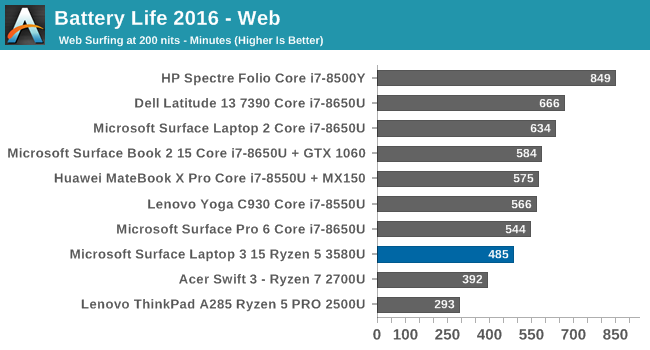
Our newer web test is much more CPU intensive, and a more realistic result than the older, lighter test. As expected, the results dropped further, to just over eight hours of usage, which is still a reasonable amount of time, but well under the 10.5 hours achieved by the Surface Laptop 2.
Movie Playback
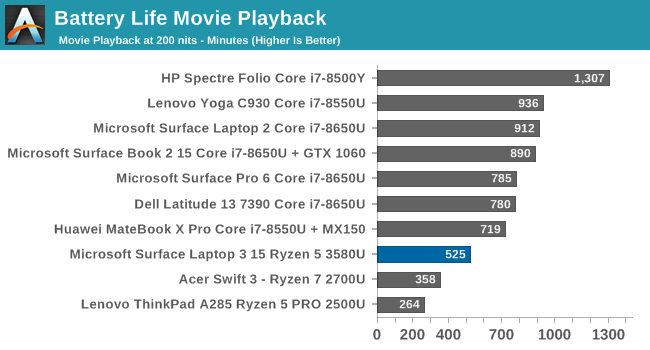
Video playback is one of Intel’s strengths, but it continues to be one of AMD’s weaknesses, with video playback time far shorter than the Intel offerings. Intel has put a lot of effort into offloading the video playback to fixed function hardware and turning the rest of the chip off, and while AMD certainly has hardware decode on their APU, it clearly can’t turn off the rest of the chip during playback, since the battery run time is somewhat less than our light web test.
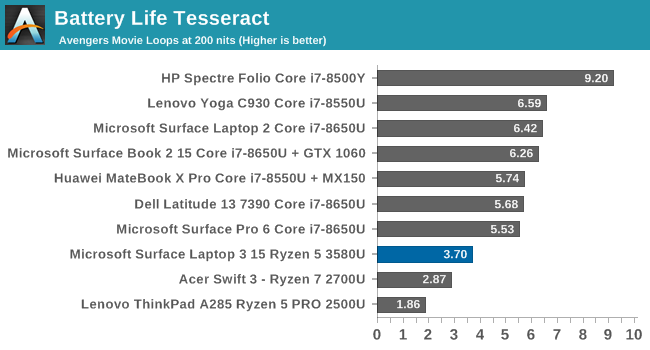
On the Tesseract score, the Surface Laptop 3 is still able to watch almost four entire sittings of The Avengers, which is a lot, but well under the 6.4 plays on the Surface Laptop 2.
Normalized Results
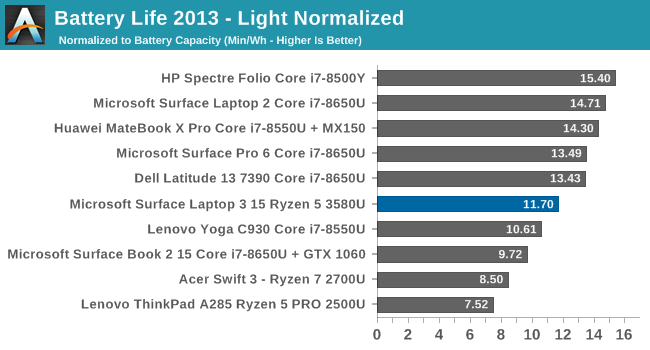
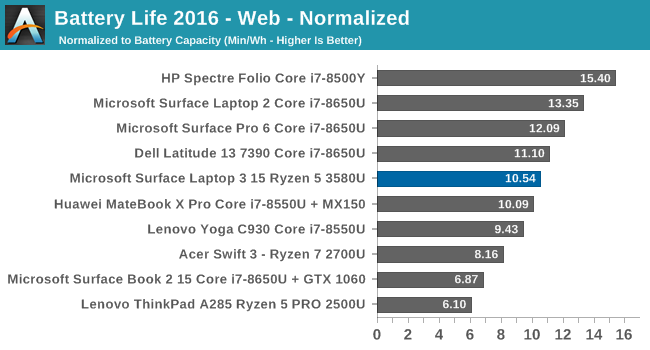
Removing the battery size from the runtimes lets us look at overall platform efficiency during the tests, and removes the insane runtime the Surface Book 2 provides thanks to its massive battery. Here the results are mixed. AMD has certainly made some tremendous strides in improving the abysmal platform power of the Ryzen APU from the original Raven Ridge to the current Picasso platform, with a much better showing in both the light test and 2016 Web results. Some of the discrepancy would come down to the display as well, since the larger 15-inch IGZO panel will need more power to light up to 200 nits than an equivalent 13.5-inch that we see in the Surface Laptop 2, but AMD definitely has more work to do in order to bring Ryzen's platform power down to what Intel has achieved.
The Acer Swift 3, which was the first Raven Ridge laptop we tested, drew 5.71 watts of power at idle with the display at 200 nits. That actually compares favorable with a Surface Book 2 15, which draws about the same – 5.53 Watts at idle with the display at 200 nits, but the main difference is the Surface Book 2’s display is the majority of the power draw thanks to its high resolution and 15-inch size. Removing display power from the devices results in the Acer Swift 3 drawing 4.55 watts at idle, and the Surface Book 2 drawing just 1.43 watts. The HP Spectre Folio, which features a Core i7 Y series processor, draws just 750 mW of power at idle.
The Surface Laptop 3 draws right around 5 Watts of power at idle with the display at 200 nits. That’s once again similar to the Surface Book 2 15, which draws 5.53 Watts. However, the Surface Laptop 3’s lower resolution display accounts for much less of the total platform draw. Removing the display from the equation results in the Surface Laptop 3 still drawing 2.35 Watts at idle. That’s significantly more than an Intel platform. So, while AMD has improved their battery draw tremendously, 2.35 Watts of idle power draw is still a lot and leads to the 15-inch Surface Laptop 3 delivering less battery life than the Surface Laptop 2, which was 8th generation Intel.
Charge Time
To make up for the less than amazing battery life of the Surface Laptop 3, Microsoft does include a stout 65-Watt charger which connects to the Surface Connect Port. All Surface power bricks also include an integrated USB-A output which is very handy when traveling if you need to charge your phone, although they may need to add USB-C soon.
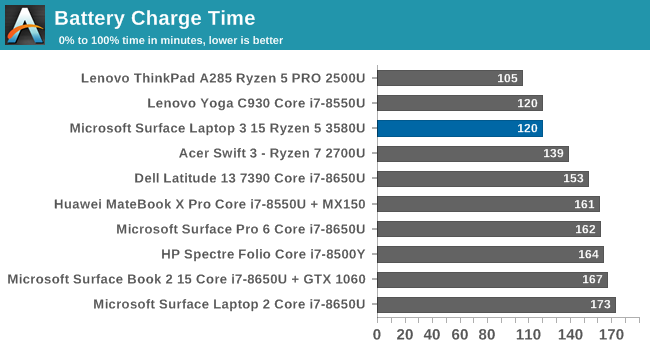
The Surface Laptop 3 charged very quickly. The smaller than average battery sized coupled with a larger than average adapter gave Microsoft lots of capacity to quickly get the Laptop 3 back up to a full charge.










91 Comments
View All Comments
Icehawk - Thursday, October 24, 2019 - link
I get that we always want the best but I honestly don't know why it's harped on about how this device "only" does ~315 which is about as fast as a SSD can handle anyway - 1G connects for a single machine just don't matter in real life. More important to me is how reliable the connection is, which according to this review is solid.Eliadbu - Monday, October 21, 2019 - link
I'll give that the GPU is compelling but all other aspects of the APU are mediocre, especially the battery life which worse than average. I would like to see how the ice lake version compares to this APU.I think this machine proved why Intel still dominates the low power/thin and light laptops market.
Irata - Monday, October 21, 2019 - link
Did you look at the system performance benchmarks? Ryzen 5 does pretty well there (second place overall in PC Mark 10) and the list does not include any Core i5, only core i7.The only laptop that has a higher score is the top of the line Surface Book 2 with an i7 plus nVidia dGPU.
The Ryzen model tested here is the base model, btw.
Yes, battery life could certainly be better (although they do not test how well it does under load), but Surface Book Ryzen us not the worst - there are Intel based models that do less well.
phoenix_rizzen - Monday, October 21, 2019 - link
Yeah, if you consider this is the middle-of-the-road APU (R5) from AMD being benched against the top-of-the-line CPUs (i7) from Intel, it does really well. For most of the CPU benchmarks, it's right in the middle of the i7 pack. For most of the GPU benchmarks, it's better than the iGPU, as good as the MX150 dGPU, although not nearly as good (as expected) as the 1060 dGPU.Would be interesting to see how this APU compares to i5 versions of these laptops.
Would also be interesting to see how the R7 APUs compare to the i5 and i7 versions of these laptops.
Eliadbu - Monday, October 21, 2019 - link
this is 8th gen, meaning we are comparing to the past products, you talked about r7 but from what I've seen we are talking 100-200mhz difference (so 5% difference at most ). also the TDP will get up as clock speed goes up which equal to more heat,worse battery life etc. many test that it did perform good is due the GPU as I said it is compelling but is it enough I would say no, and for testing battery life under load I would say while it might have some use cases most people will use the laptop on battery for basic tests like browsing the web, watch videos, edit documents or other light use programs. if the r5/r7 had lower price I would give it more favor but as it stands out it does not give us any discount, it may have been due Microsoft pricing tactics but it does not change the fact. also we need to see how it compares to ICL version of this machine. I would guess it would still have the better GPU but the gap would shrink significantly, and CPU would not be it strong side either.Potato Power - Thursday, October 24, 2019 - link
Microsoft puts a 46Wh battery inside. That explains why the battery life is only so so. Even my cheapy Zenbook has a bigger battery.sorten - Monday, October 21, 2019 - link
Decent showing against previous generation Intel options, meaning it wasn't as far behind as I expected. Unfortunately for AMD, Ice Lake offers better than 2x the iGPU performance of 8th gen chips, and there will also be a minor bump on CPU performance, battery performance, and memory speed.Kishoreshack - Monday, October 21, 2019 - link
People overreacting should understand this is the base model, for a base model it competes very we with top end models of last yearI would be really excited to see higher end models of surface laptop 3
AMD VS INTEL COMPARISON
Felt that surface should have integrated ZEN 2 ARCHITECTURE INTO THESE LAPTOPS
TheinsanegamerN - Monday, October 21, 2019 - link
Except this "base" model has worse IRL GPU performance, worse batery life, and worse wifi. It is a step backwards. AMD GPUs are supposed to be better then intel, but the graphs here show that is not hte case unless power isnt a consideration.Kind of hard for MS to use ZEN 2 ARCHITECTURE APUs when they refuse to make them. AMD is just crippling themselves here.
Fulljack - Tuesday, October 22, 2019 - link
eh, it shows the igpu as the most powerful one, even beating mx150 which is a dgpu on some scenario. too bad the graph still hasn't show Intel gen11 graphics. so I don't get what do you mean by worse irl gpu performance.of course, as expected, it won't beat gtx 1060 due to sheer amount of difference both in tdp and die size.